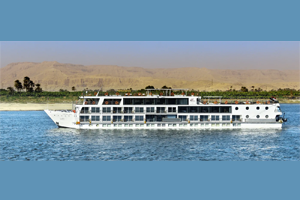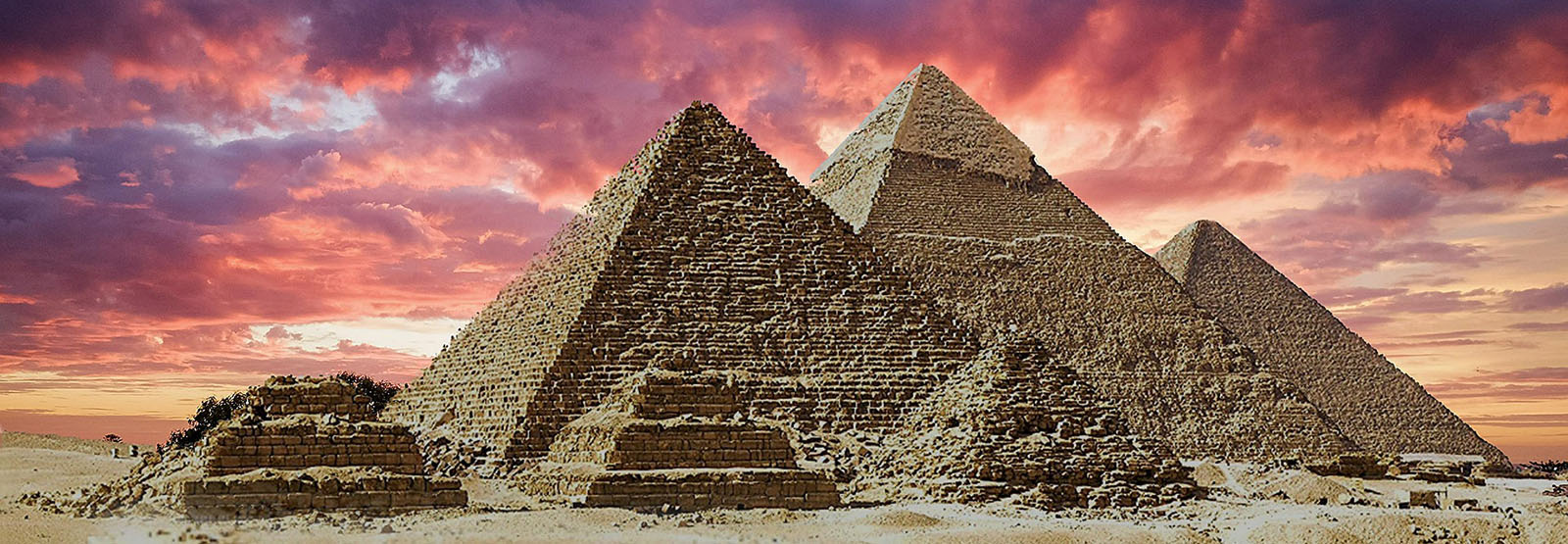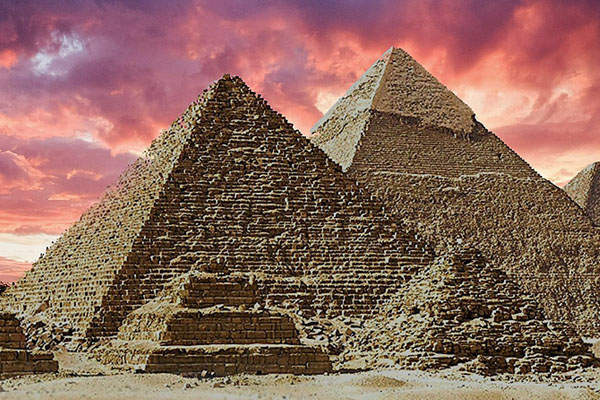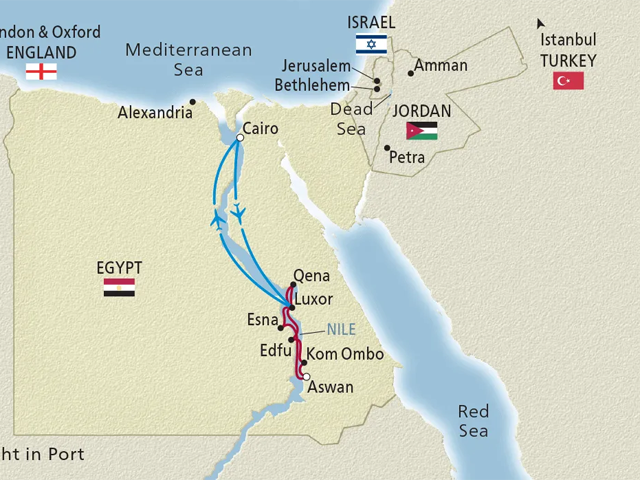HIGHLIGHTS
- The
pyramids and the Sphinx, the only Ancient Wonders of the World still
standing
- Cairo’s
Museum of Egyptian Antiquities, featuring the treasures of King
Tutankhamen
- Luxor’s
Karnak Temple complex
- The
Necropolis of Thebes, Egypt’s largest repository of pharaonic
tombs
- Luxor
Temple, with its sphinx-lined avenue
- Privileged
Access to the tomb of Nefertari in the Valley of the Queens
- The
graceful temple of Hatshepsut, Egypt’s only female pharaoh
- The
temple of Hathor at Dendera
- Aswan’s
atmospheric souk
- Nubian
village and school visit
- The
romantic, waterbound Temple of Isis at Philae
- Horse-drawn
calèche tour to Edfu’s Temple of Horus
DATES / RATES
Rates are listed per person
|
| Start Date | End Date | From EUR | From USD |
|---|
| Dec 26, 2025 | Jan 06, 2026 | 6,181 |
6,999 |
Rates are listed per person
|
| Start Date | End Date | From EUR | From USD |
|---|
| Dec 26, 2025 | Jan 06, 2026 | 6,181 |
6,999 |
ITINERARY
Day 1
Cairo, Egypt
Arrive and check in to your hotel. It has been said of Egypt’s exhilarating capital, “He who has not seen Cairo has not seen the world.” Certainly, the heart of the nation beats with an unbridled passion in this city made prosperous over millennia as a stopover for Sahara caravans on trade routes to Byzantium. Amid the stimulating strum, the insistent beauty of everyday life reigns here, with the serene Nile sliding through like an entrancing serpent. Cairo’s very age mesmerizes; its monuments have stood here for more than 5,000 years.
Day 2
Cairo, Egypt
For centuries, Cairo has played a central role in religious and cultural developments in Egypt. Today, the city is home to the only Wonder of the Ancient World still intact—the Great Pyramids of Giza. And the city’s historic district, Old Cairo, boasts the world’s highest concentration of Islamic architecture. In addition to these monuments, Cairo has been making efforts as a member of the UNESCO Creative City of Crafts and Folk Art to preserve its traditional craftwork heritage including glassblowing, coppersmithing, pottery, ceramics and jewelry.
Day 3
Cairo, Egypt
A captivating world that has withstood the tests of time unfolds beyond the medieval walls enclosing Old Cairo. Muizz Street, named for the Fatimid caliph who established Cairo as Egypt’s capital in 969, was the city’s main thoroughfare, running between the 11th-century city gates Bab al-Futuh and Bab Zuweila. Its splendid Islamic architecture—from elegant mosques and mausoleums to ornate palaces and former residences of Egyptian dignitaries and prominent merchants—provides a glimpse into the glory of the Fatimid dynasty and the periods that followed.
Day 4
Luxor, Egypt
After breakfast, check out of your hotel and fly to your embarkation city. Luxor is set on the east bank of the Nile River and once served as the capital of Egypt’s New Kingdom. Today, it is a UNESCO World Heritage Site lined with beautiful colonial hotels and some of the world’s most ancient and significant ruins. Many consider this city, watched over by graceful single-sailed feluccas plying the Nile, one of the world’s great open air museums. The sprawling Temples of Luxor and Karnak on the east bank are linked by the ancient Avenue of the Sphinxes. On the west bank, in the Valley of the Kings, lie the tombs of Egypt’s great pharaohs.
Day 5
Qena, Egypt
Known in ancient Egypt as Caene, Qena’s situation on the banks of the Nile River has bolstered its prosperity over millennia. Merchants and travelers have long journeyed here from the Red Sea, through the valley, bringing goods from Persia and beyond. The Sheikh el-Qenawi Mosque on the main square serves as a monument to the city’s rich and all-embracing Islamic and Sufi past. Qena is mostly known as the gateway to the magnificent ruins of the Dendera Temple. Its stone gate and towering columns adorned with hieroglyphics are some of Egypt’s best-preserved structures.
Day 6
Luxor, Egypt
Luxor lies amid what is arguably one of the world’s largest archaeological sites: Thebes, once a thriving imperial capital. In antiquity, the Nile River ran through Thebes, dividing it into a “City of the Living” and a “City of the Dead.” The former referred to the east bank (modern-day Luxor) as this was where the majority of the city’s population—and at times, Egypt’s rulers—made their home. The west bank (known today as Kurna) was designated the latter as it served as a necropolis, dotted with the lavish resting places of royalty and other nobility.
Day 7
Esna, Egypt
Ancient Egyptians knew Esna as Latopolis, named for the largest of the perch species that swam in the Nile’s sacred waters. Its ancient past lives on in the colorful street market overflowing with fabrics, carpets, brassware, mother-of-pearl keepsakes and more. Esna’s glorious Temple of Khnum is celebrated for its 1st-century Roman Hypostyle Hall, 24 columns topped with intricately carved floral capitals. Its walls are adorned with images of Roman emperors making offerings to Egyptian gods.
Day 8
Aswan, Egypt
Aswan stands at what was once the northern border of ancient Nubia, a remarkable region that encompassed the land eastward from the Libyan Desert to the Red Sea and northward from central Sudan to southern Egypt. As a UNESCO Creative City of Crafts and Folk Art, present-day Aswan strives to preserve its rich heritage. Its efforts include the Aswan Folk Dance Troupe that performs internationally, the Nubian Museum showcasing Nubian daily life and craftwork, and the Aswan International Symposium of Sculpture encouraging the practice of ancient Egyptian granite stone carving.
Day 9
Aswan, Egypt
Located at the first cataract of the Nile, a set of rapids coursing through a rocky riverbed, Aswan has long been a terminus town on the Nile. Today, the trading tradition continues in the city’s lively market near the Nile’s banks. The city also thrived due to the massive quantities of granite quarried here to build the country’s countless ancient temples, obelisks and pyramids. In the 1960s, completion of the Aswan High Dam created Lake Nasser. As the lake rose, the city became a magnet for archaeologists intent on saving ancient temples from submersion.
Kom Ombo, Egypt
Kom Ombo is a small town along the Nile. In the heart of one of Egypt’s fertile agricultural regions, it is surrounded by vast fields of sugarcane and corn. The village is home to a large Nubian population, many of whom were displaced when their homes were submerged by construction of the Aswan High Dam and the creation of Lake Nasser. The town’s highlight is its namesake temple, perched on a low hill overlooking the Nile. Construction was started by an Egyptian pharaoh in the 2nd century BC and completed by a Roman emperor around 30 BC.
Day 10
Edfu, Egypt
Edfu is steeped in Egyptian legend. In this sacred place, ancient myth says that the falcon god Horus battled his uncle Seth after Seth brutally killed Horus’s father Osiris. To honor Horus, the people of Edfu built a grand temple from 237 to 57 BC, a young structure by Egyptian standards. Egyptologists have paid particular interest to its design, as it closely resembles that of much older temples. Nearby, an ancient settlement provides hints of life along the Nile, with its interesting artifacts dating as far back as 3100 BC.
Luxor, Egypt
Home to a wealth of archaeological treasures, Luxor boasts a rich history and cultural heritage. One of the best ways to experience this is with a visit to the Luxor Museum. Located downtown, its doors have been opened to the public since 1975, when it was founded under the initiative of the Ministry of Culture of Egypt. Its thoughtfully curated collection showcases artifacts spanning from the Old Kingdom to the Mamluk sultanate. Among its most notable exhibits are those displaying the mummies of Ahmose I and Ramses I, and objects excavated from King Tutankhamen’s tomb.
Day 11
Cairo, Egypt
After breakfast, disembark your ship and fly to your destination. Arrive and check in to your hotel. Souks (marketplaces) are central to Egypt’s social, cultural and economic traditions. A microcosm of the city, they provide a glimpse into local life, history, art, crafts and food. And in Cairo, they are in abundance, with one of its most notable lying in the historic heart of the city. Originally established as a caravansary in 1382, Khan el-Khalili is not only the largest souk in Cairo, but also the oldest in the Middle East. Its vast labyrinth of passageways is lined with bustling stalls and shops offering a wide range of goods.
Day 12
Cairo, Egypt
Bid farewell to your fellow guests and journey home. Or spend more time exploring, perhaps joining one of our extensions.
Viking Ra (Luxury Expedition, 52-guests)
Named after the ancient Egyptian god of the sun, the Viking Ra is a
state-of-the-art vessel—owned and operated by
Viking—specifically built to cruise the Nile. Designed in the
clean, elegant Scandinavian aesthetic for which Viking is known, she
offers the ultimate in comfort.
 (Click image to view Ship details)
(Click image to view Ship details)
WHAT'S INCLUDED
- One
complimentary shore excursion in every port of call
- Free
Wi-Fi (connection speed may vary)
- Beer,
wine & soft drinks with onboard lunch & dinner
- 24-hour
specialty coffees, teas & bottled water
- Port
taxes & fees
- Ground
transfers with Viking Air purchase
- Visits
to UNESCO Sites
- Enrichment
lectures & Destination Performances
Your Stateroom Includes:
- River-view
stateroom
- Bottled
water replenished daily
- 110/220
volt outlets
- Queen-size
Viking Explorer Bed (optional twin-bed configuration) with luxury
linens & pillows
- Private
bathroom with shower, heated floor & anti-fog mirror
- Premium
Freyja® toiletries
- Plush
robes & slippers (upon request)
- 40"
or 42" flat-screen Sony® TV with infotainment system featuring
Movies On Demand, plus CNBC, CNN, FOX & more
- Telephone,
safe, refrigerator
- Individual
climate control
- *All
amenities on board Viking Longships; amenities vary on other ships.







